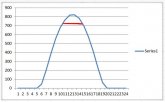IMHO, as long as you stay comfortably within the specs of your solar controller, "over paneling" has only one significant downside and that is wasted potential energy. The good news is you don't waste much energy and you waste it only on the best "solar" days. Those days might be a concern if one is running A/C from solar but not for the rest of us. If you have a spreadsheet program (Google Sheets or Excel) and want to know how much energy is being wasted, go to the National Renewable Energy Lab's website and run their PVWatts model. Input your data and download the hourly file and plot the summer (June mostly) days when clipping will occur. The clipping is evident. If you wish, make runs with a full size controller and a smaller controller and compare them. You will see results like this plot of hourly Watthours ........ This is a fairly extreme case, a 1000W array that could do 820W but is limited to 720W by clipping. The over paneling in this case was 40 or 50% IIRC. On a rare day when the array could otherwise be doing 900W, the loss would be greater but this might happen only on a few days in June.
 NREL PVWatts Calculator
NREL PVWatts Calculator
Data you enter ......................
Location: enter a location where you camp
DC System Size (kW): your panel total Watt/1000
Module Type: usually premium (~20% efficiency)
Array Type: enter yours, mine is fixed roof
System Losses (%): I use 7%, includes those relevant to RVs
Tilt (deg): usually zero
Azimuth (deg): relevant only if next above is not zero
DC to AC Size Ratio: For us this is the panel array to Controller output limit
Inverter Efficiency (%): 96% is typical for 12V, use 97% for 24V
Ground Coverage Ratio: 0.4
Scroll down the page a bit and click on the hourly download option.
PVWatts gives you monthly energy loss due to clipping without the download, but that's not very useful to us because we are interested in specific low-solar days and similar; i.e., inclement weather days. PVWatts output is "statistically representative" so shows representative weather effects for each location.





